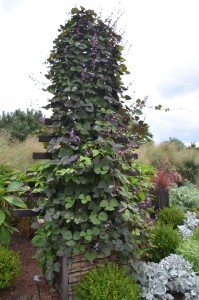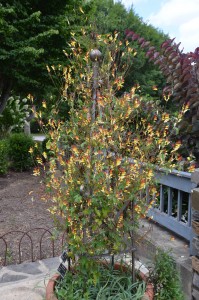For some gardeners planting vines is not for the faint of heart. Vines need space, support, training, and for some – lots of pruning. Some vines don’t demand lots of room while others chew up lots of space. Small vines like clematis or annual morning glories (Ipomoea) may be grown in a large patio container for many years on heavy duty cord, wire or wood lattice trellis. Some woody vines become massive and need support on a solidly built pergola. To select the best vine for your space, consider the following tips.
Is the vine an annual or tender perennial or a long-lived woody vine like trumpet (Campsis), climbing hydrangeas (H. petiolaris anomalis), crossvine (Bignonia capreolata), and wisteria (Wisteria spp.)? Long–lived woody vines need to be cut back hard from time to time; the vine’s trunk and main branches may become enormous and need space to grow and a structure sturdy enough to support it.
Annual vines are great for tucking into small garden spaces, including on patios and decks. Instead of building a trellis, you might allow annual morning glories to weave through nearby shrubs and trees for support. Plant the annual vines in decorative containers and climb onto a nearby shrub or tree via tendrils.
Some examples of annual vines include hyacinth bean (Lablab purpureus), climbing black-eyed Susan (Thunbergia alata), Spanish flag (Ipomoea lobata), and morning glory vines. They usually do not hurt adjacent trees for support and die off in fall. Beware – some vines will disperse a large number of seeds.
Vine’s Level Of Annual Maintenance: Woody vines like trumpet vine and wisteria can become pruning nightmares and quickly become unmanageable. These vines grow tall, ramble, and often require working from ladders.



 Posted in
Posted in 
